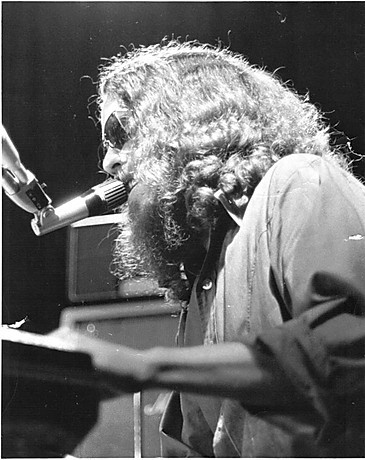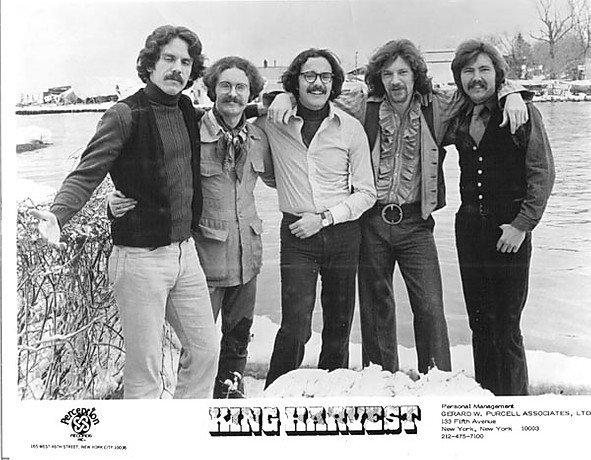The anticipation was building. This weekend was supposed to be a musical highlight – a concert featuring Pure Prairie League, Poco, and Orleans. As a huge fan, the Orleans set, especially their rendition of “Dancing in the Moonlight,” was something I was eagerly awaiting.
 Sherman Kelly onstage in the 1970s
Sherman Kelly onstage in the 1970s
Sherman Kelly performing live in the 1970s, showcasing his early musical career.
However, like many events in early May 2020, the COVID-19 pandemic put a stop to those plans, leaving the concert season in question. In the lead-up to the would-be show, YouTube became my concert hall, particularly for Orleans’ cover of “Dancing in the Moonlight,” a King Harvest classic penned by Sherman Kelly. This song, “Dancing in the Moonlight,” has always resonated with me, a favorite from the golden era of 1970s music. Originally released on July 9, 1972, by King Harvest, it soared through the charts, peaking at No. 10 on the Cash Box Top 100, No. 13 on the Billboard Hot 100, and No. 22 on the Billboard Easy Listening chart.
While indulging in YouTube versions, something caught my eye in the comments section of an Orleans video of “Dancing in the Moonlight.” There it was, a comment from Sherman Kelly himself, posted just five months prior. A wave of excitement washed over me. As someone captivated by the narratives behind iconic songs and albums – the very essence of The Vinyl Dialogues – an idea sparked: Could I reach out to Sherman Kelly and delve into the story behind “Dancing in the Moonlight”?
To my delight, I did. And he agreed. Prepare to be surprised, because the true story behind “Dancing in the moonlight” is far from what you might expect.
From Island Misadventure to Moonlight Inspiration
 King Harvest in 1972
King Harvest in 1972
King Harvest band members in 1972, the year their version of “Dancing in the Moonlight” became a hit.
The year was 1969. Sherman Kelly and his friends were managing a nightclub in the idyllic St. Thomas, Virgin Islands. Seeking a day of adventure, they chartered a 65-foot yacht to St. Croix. Little did Kelly know, he was susceptible to seasickness. The voyage proved turbulent, leaving both him and his girlfriend severely ill.
Upon reaching St. Croix, the group disembarked in search of dinner. However, Kelly and his girlfriend, still battling seasickness, had lost their appetites. As the rest of the group returned to the yacht for the night, Kelly and his girlfriend gazed at the boat’s mast swaying in the harbor. The thought of another bout of seasickness was unbearable, so they decided to find lodging in town.
A significant problem arose: in his seasick haze, Kelly had left his wallet on the boat, leaving him without cash or credit cards. They approached a small inn, explained their predicament, and offered to settle the bill in the morning when Kelly could retrieve his wallet.
“And he said, ‘Sure, you can stay here if your girlfriend will sleep with me,'” Kelly recounted in a phone interview from his home in New York’s Finger Lakes region.
Rejected by a second inn as well, Kelly’s girlfriend suggested, “It’s a beautiful night. Why don’t we just stretch out on the beach?”
“So we did,” Kelly said. “And that’s all I remember very clearly.”
The events that followed were pieced together from fragmented memories and accounts from others. While sleeping on the beach, Kelly and his girlfriend became victims of a brutal St. Croix street gang. Kelly was viciously attacked by five gang members wielding baseball bats. His girlfriend was raped by the gang leader while the others waited their turn. However, in a courageous act, Kelly’s girlfriend later reported that he regained consciousness during the assault and fought back, creating enough commotion to frighten off the attackers.
Disoriented and drifting in and out of consciousness, they stumbled along the shoreline, guided by the lights, eventually reaching the only hospital in St. Croix. Kelly and his girlfriend were believed to be among the early victims of the infamous Fountain Valley Gang, who in 1972 perpetrated a mass murder of eight tourists and wounded eight others, devastating St. Croix’s tourism industry for years to come.
“I woke up to the sound of my hospital roommate screaming in pain. Finally the screaming stopped, and I heard two doctors talking about him. ‘That’s it, he’s gone,’ said one doctor about the other patient. ‘What about him, you think he’s gonna make it?’ And the other doctor said, ‘No, I doubt it.’ I realized they were talking about me,” Kelly recalled.
Against the odds, Kelly survived. He spent several days recovering in the St. Croix hospital before returning to St. Thomas. He then stayed at a friend’s home while recuperating further. Eventually, he was well enough to return to New York, where doctors at New York Hospital undertook the task of re-breaking and resetting the bones in his face and addressing his other injuries.
Back home in Ithaca, New York, still enduring pain and persistent headaches, Kelly was in no condition to perform with a band. However, his creative spirit remained undimmed, and he turned to songwriting.
It was during this period of convalescence that the seeds of “Dancing in the Moonlight” were sown. “I envisioned an alternate reality, the dream of a peaceful and joyous celebration of life. It was just me imagining a better world than the one I had just experienced in St. Croix,” Kelly explained.
From an unspeakably traumatic experience that nearly claimed his life emerged a song of hope and joy. “It was amazing. People liked the song right from the start. I liked it, but I wouldn’t have predicted that it would become a big hit,” Kelly admitted.
Boffalongo Beginnings and a Song’s Journey
 Boffalongo, circa 1970
Boffalongo, circa 1970
Boffalongo band photo from around 1970, featuring Sherman Kelly during his early band days.
King Harvest wasn’t the first to record “Dancing in the Moonlight.” In 1970, Kelly joined Boffalongo, a band that included his brother, Wells Kelly, guitarist Larry Hoppen, bassist and keyboardist Dave “Doc” Robinson, and Peter Giansante. “Dancing in the Moonlight” found its first album home on Boffalongo’s 1970 release, “Beyond Your Head.” This initial version featured Sherman Kelly on lead vocals, Wells Kelly on drums, and Larry Hoppen on lead guitar.
However, Kelly is self-deprecating about his vocal performance on this version. “The first time I was in a recording studio for that version, we had these producers who thought it was a good idea to give me cocaine. That was probably the worst idea,” Kelly revealed. “I found myself in the vocal booth, where there were a lot of people distracting me. And the producers would give me more cocaine to keep me doing takes until my voice was so distorted and so weird.”
Despite Kelly’s vocal reservations, the Boffalongo version gained regional popularity, becoming a local hit. Interestingly, another group called High Broom also recorded “Dancing in the Moonlight” in 1970, releasing it on Island Records, but it didn’t chart.
When Boffalongo disbanded, Wells Kelly joined King Harvest, a French-American group then based in Paris. King Harvest’s lead singer was none other than Doc Robinson, also formerly of Boffalongo. It was Wells Kelly who introduced “Dancing in the Moonlight” to his new bandmates.
King Harvest’s Hit and Enduring Popularity
The King Harvest rendition of “Dancing in the Moonlight” featured Robinson on lead vocals and was released as a single with “Lady Come Home” as the B-side. This version became the breakthrough hit, propelling the song into the national spotlight.
Once the song’s popularity exploded, King Harvest invited Sherman Kelly to tour with them during the summer of 1972. In live performances, Robinson handled the lead vocals on “Dancing in the Moonlight,” while Sherman Kelly contributed harmony.
“Doc had a pretty good voice, better than mine,” Kelly conceded. “I remember one critic said about me, ‘As a singer, Sherman Kelly is not too bad of a songwriter.’ That was amusing, and true.”
However, the rigors of touring with King Harvest weren’t for Kelly. His stint with the band lasted only that one tour. “Imagine yourself in your twenties and you’ve written a hit song, you have some chart action and you’re traveling around. It was fun for a while,” he said. “But life on the road is ridiculous. I didn’t really care for it after a while.”
Wells Kelly eventually departed King Harvest and reconnected with John Hall. Wells Kelly, Hall, and Harvey Brooks had previously played together in a band called Thunderfrog in the late 1960s. Together with Larry Hoppen from Boffalongo, Wells Kelly and Hall formed Orleans. Orleans, too, would record their own version of “Dancing in the Moonlight,” further cementing the song’s legacy. The current iteration of Orleans, still featuring Hall and Larry Hoppen’s brothers, Lance and Lane Hoppen, continues to include “Dancing in the Moonlight” in their setlists. Larry Hoppen passed away in 2012.
Beyond the Moonlight: Sherman Kelly’s Journey
 Sherman Kelly today
Sherman Kelly today
Sherman Kelly in a recent photo, reflecting on his diverse life and career beyond music.
Sherman Kelly’s path extended far beyond the realm of music. He graduated from Cornell University in 1967 with degrees in psychology and English. He furthered his education at Alliance Francaise in Paris, the University of Lausanne in Switzerland, and the New School for Social Research in New York City – all before penning “Dancing in the Moonlight.”
Following the tragic death of his brother Wells Kelly in 1984, music became too painful for Sherman. He shifted his focus and earned a master’s degree in social work and psychotherapy from Syracuse University in New York. For many years leading up to his retirement, he worked as a psychotherapist.
In 2008, Kelly returned to his musical roots, releasing an album titled “Burnin’ the Candle,” which included unfinished songs he and Wells Kelly had collaborated on.
In 2000, “Dancing in the Moonlight” experienced a resurgence when Toploader covered the song, scoring another hit. The song has also graced various films and television shows. In 2017, it was featured in the video game “Guardians of the Galaxy: The Telltale Signs,” serving as the opening theme for the second episode.
“Dancing in the Moonlight,” a song born from trauma, has become a timeless anthem of joy and escapism, its journey as captivating as its melody.
